History
The fascinating past of the Jewish community in Norwich
history
The Jews in Norwich 11th to 21st Century
by Maureen Leveton
The history of the Jewish people in Norwich goes back a very long way, and it is for this reason that Norwich has earned its reputation as an important city in the annals of British Jewry. It is one of which we should be proud. I have briefly documented on the next few pages the history of the Jews in Norwich, particularly in celebration of the 40th anniversary of the consecration of our Synagogue. The more recent history over the last 50 years, has had to be limited, for this purpose, to recording the Ministers and Lay-Readers and their time in Norwich, omitting many of the other events and personalities associated with the community. These will come later in more detail in my expanded history, I hope.
The Crusades in the 11th century, many of them also directed against European Jews, encouraged those that were left to follow William the Conqueror to England after his invasion in 1066, particularly after massacres of Jews in France in 1096. The Jews’ role as moneylenders had helped to finance William’s conquest of England. Norwich, an important provincial capital, had need of money to facilitate business, so the Jews’ skills as money lenders was welcomed.
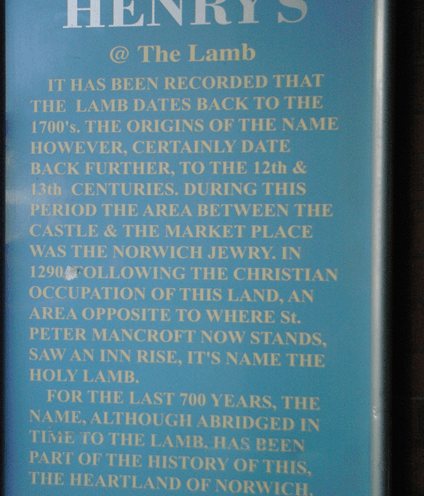
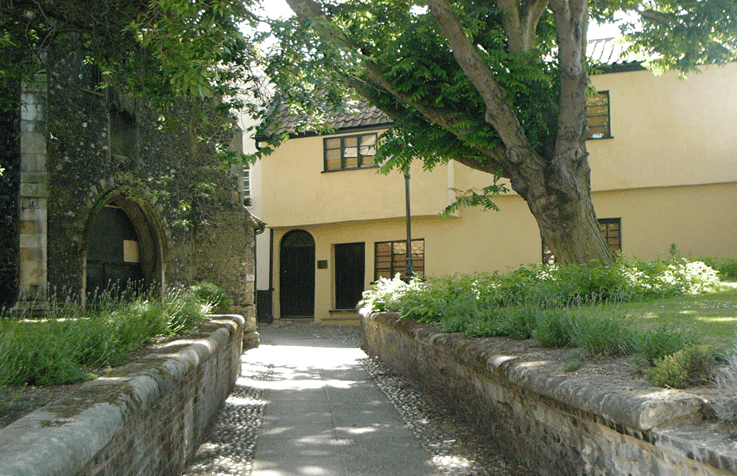
The first known Synagogue, dating approximately between 1087 and 1100 was in today’s Dove Street, then known as Holtor Lane. There is no trace of any such building today. Following this the Jews mainly settled in Norwich below the Castle in what is now the White Lion Street area of Norwich, so they were close to the Castle where the King’s representative lived. He had protection of the Jews and close to this is where the main medieval Synagogue was built. The site of the Synagogue was known to be approximately on the site of the old Lamb Inn and the present store, Primark. In the 1960s when buildings on the Primark site were demolished to make way for a new store, then Littlewoods, remains were found of glazed tiles and parts of pillars which were dated to the period of the 12th or 13th century. The synagogue was destroyed either by fire in 1286 or by demolition in 1290, when the Jews were expelled from England. There was a plaque in the Lamb Inn passage for many years to record the site of the mediaeval Synagogue. (see photo). However, in recent times this was removed by the owners of the pub, and to date has not been replaced.
Jurnet’s house in King Street, now Wensum Lodge (see photo), was the home of Jurnet, one of the richest Jews in England at the time and this house was also owned by his son, Isaac, in 1197. The family was very rich and lent money to successive kings to build castles, cathedrals and churches, which included Norwich Cathedral. There are many records still available in the Westminster Abbey Muniment Room, documenting the Jurnet family’s lending.
The other well-known fact about the Jews of this period was the story of William of Norwich, the first blood libel, sadly attributed to our city. The death of a young man, William, on erev Pesach 1144 was blamed on the Jews, said to have used the child’s blood to make matzah for Passover, a ritual killing. The Jews were protected by the Sheriff, and they were allowed to take refuge in the Castle and he refused to allow proceedings to be taken against them. Efforts were made to make William a saint. The Jews of this period lived in dangerous times, with several records of massacres of Jews in different parts of the country. York being the main one, but Norwich had its share.
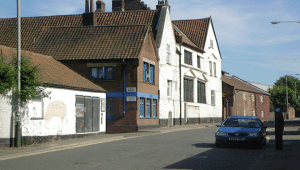
Following the expulsion in 1290, any Jews that may have been left in England went into hiding, or pretended to have converted to Christianity.
The Jews were allowed back into Britain in 1656 thanks to Oliver Cromwell, who realised the worth of the Jews to commerce. There is evidence of a community in King’s Lynn in 1747, and Cecil Roth, the Jewish historian, gives the date of the first mention of Jews resident in Norwich as early as 1750. There was a report in the local Norwich Mercury of a quarrel between the Minister and Hon. Officers of the Synagogue which resulted in a summons.
Jewish families did not exceed 20 at this time and there was known to be a room, used as a Synagogue in Gowings Court, St Stephen’s Street. The first small Synagogue was situated at the top of Tombland Alley (opposite the Cathedral, see photo). This opened in 1828 and the leader of the community was Barnett Crawcour. The records show that in that year there were 29 families who were members. Barnett Crawcour died in 1835. The new President, Joel Fox, and his committee, wanted to build a new large Synagogue as they felt their numbers were growing. They endeavoured to raise as much money as possible for the new Synagogue. This building was completed and consecrated in St Faiths Lane on the corner of a small street which was later renamed Synagogue Street. A very full article describing the consecration was reported in the Norwich Mercury of 8 September 1849. The Synagogue in Synagogue Street was a fine building (see photo below) and the community thrived, having a number of different Ministers during its 95-year life; it was destroyed by enemy action in 1942.
The Rev. Simon Caro was Minister from 1840 – 1872, a very long-serving Minister. Rabbi M Fabritz was Minister from 1921 to 1950, several others in between only serving a few years. A full list can be seen in Henry Levine’s book.
At the beginning of the 20th century the congregation had 33 member families equating to 147 people. Some names from that period are still familiar to us today. In 1909 Max Brenner joined the community and he was President from 1924 to 1925 and then again from 1935 to 1936. His family was extensive – 7 daughters and one son, Victor Brenner, who died in 2012. Isaac Leveton joined in 1891, and his son, Cyril, was President on several occasions. His son, Barry, is still active in the Synagogue today and has also been President. Henry Levine, the author of the oft-mentioned book about the early days of the community, was a member for many years. His daughter, Leona is still a member and his son, the late Desmond Levine, was a Trustee.
Following the bombing of the Synagogue in 1942, the community was offered several alternative spaces for worship by local churches; eventually they used the Spiritualist Church hall in Chapel Field North. Many American Jewish servicemen visited this building to attend services and social events during the war period and their names are inscribed in one of the Minute books of the time. Prior to the war the Norfolk and Norwich Committee for Refugees was formed which had representatives from every religious denomination in the City and County. Ben Brahams, a member of the Jewish community was chairman, and Cyril and Kitty Leveton were joint Hon. Secretaries. The committee was successful in bringing out of Germany and Austria 90 refugee children. Several members of the community had refugees to live in their own homes.
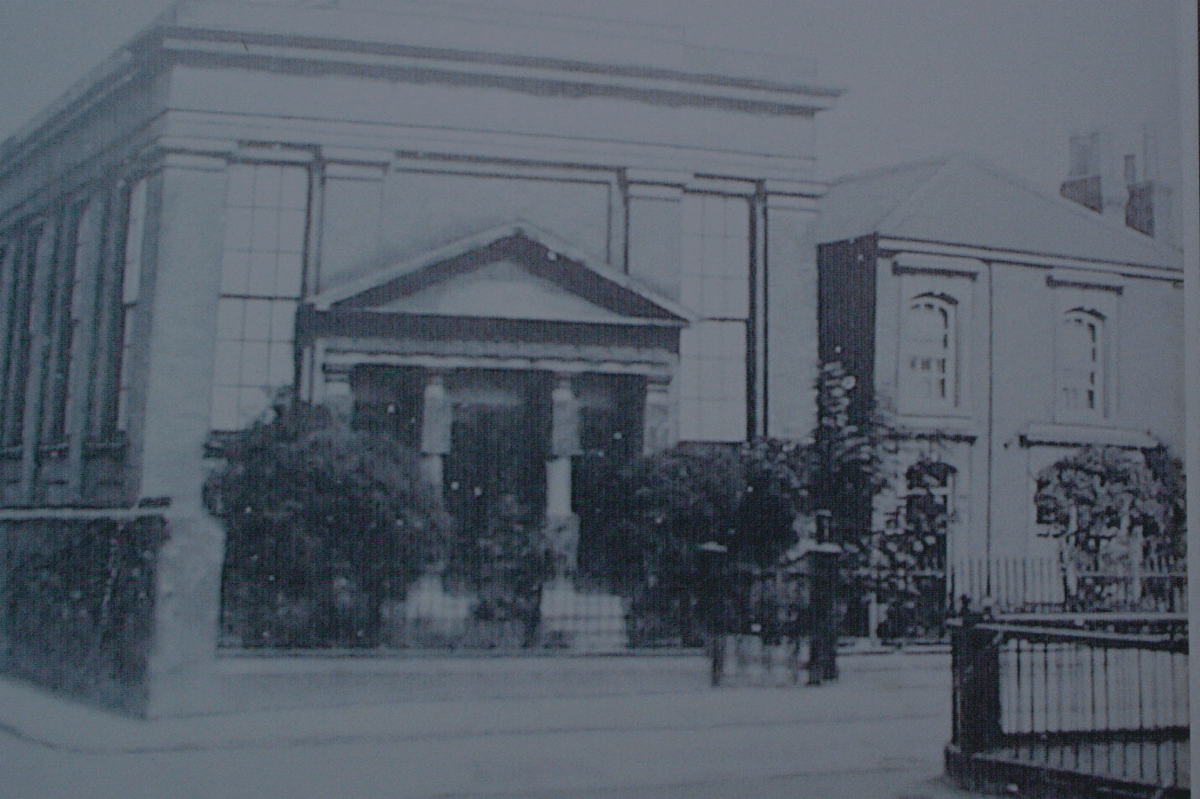
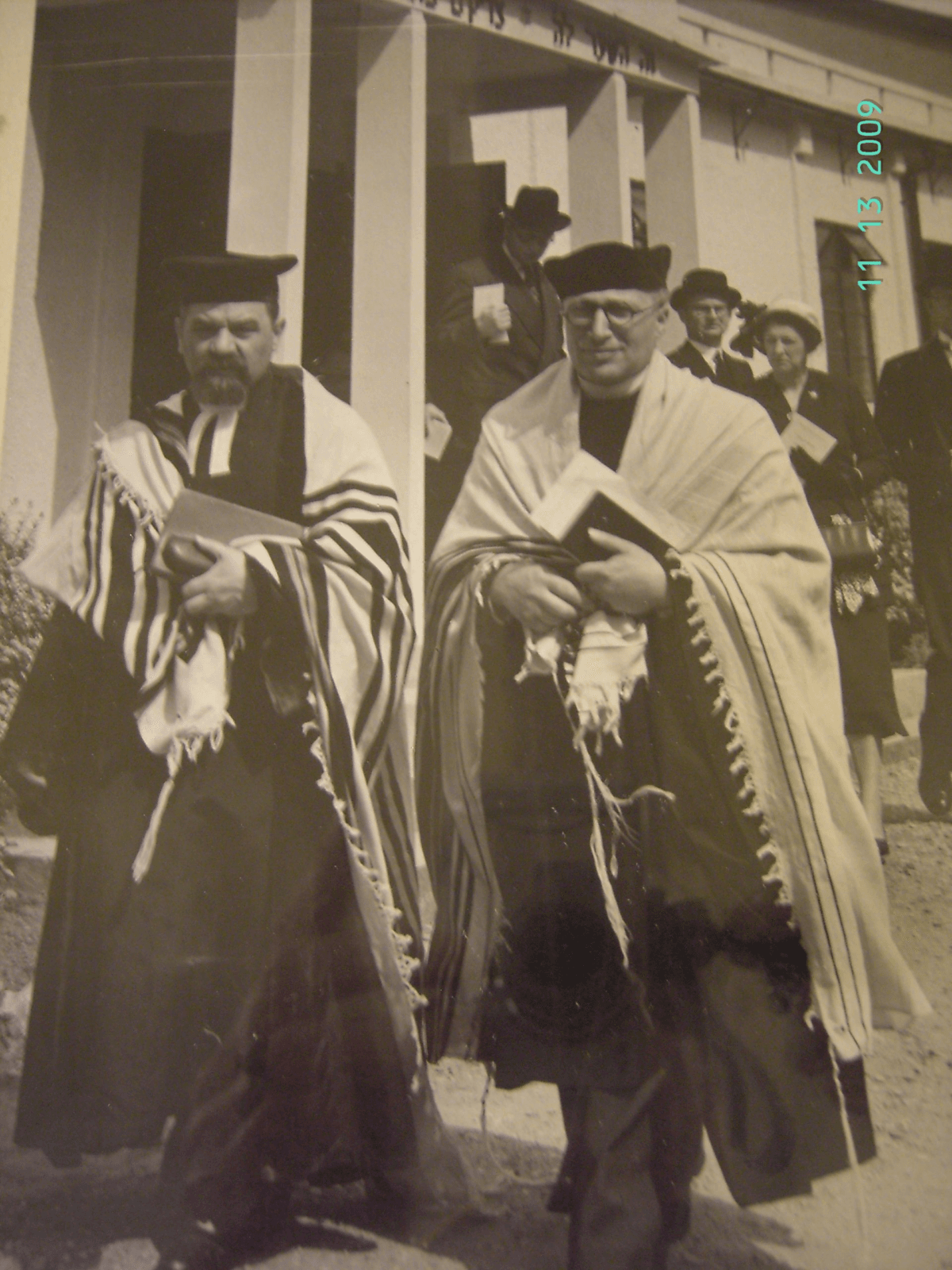
In 1948, after 6 years of temporary accommodation at the Spiritualist Church, the City Council leased to the community the present site on Earlham Road, on which a pre-fabricated Synagogue was initially erected, with an undertaking to build a permanent Synagogue within 10 years. This period had to be very much extended and our present building was not built until 1968/9. The Communal Hall with a flat above to house a Minister, was built in 1951. The photograph above shows the opening of the communal hall by the Chief Rabbi, Dr Israel Brodie, with the temporary Synagogue in the background.
A very interesting event took place in 1956 when Teddy Keller, who was President at the time, organised the Tercentenary Exhibition at the Castle Museum. (see photo of catalogue cover). This was to celebrate the 300th anniversary of the return of Jews to England, and he was able to amass a large number of records of Norwich Jewish interest from Medieval times to the 19th century. It appears to have been a very fine exhibition.
From 1955 to 1959, the Rev Harold Lerner was the Minister of the community, a very outgoing young Minister. He emigrated to Canada in 1959 and Rabbi Dr Willman was appointed the new Minister. He was originally from Nikolsburg in Moravia, managing to escape to Britain before the war. He obtained a job teaching at Hartlepool Grammar School, until he retired in 1959, when he came to Norwich.
At about this time plans began to be discussed for the new Synagogue and in 1960 when Dr Bertram Rose was President, the Building Committee was formed with Cyril Leveton as the Chairman, and Lionel Goodman, Percy Cohen, Leslie Trafford, Dr Rose and Joe King on the committee. Victor Brenner was Hon. Secretary.
Rabbi Willman sadly died in office in 1964 and is buried in the Norwich Jewish Cemetery. The Rev. Golomb succeeded him as Minister and he was a very frum, observant Rabbi, and although he invigorated the Synagogue with good teaching and instigated discussion groups and the first newsletter, he found it very difficult living out of a truly kosher environment and in 1967 he resigned to move back to London
The Synagogue was without a Minister for several years at this point and a member, Sam Stone, took over the office of lay-reader and did an excellent job. He was rewarded by the community who paid for him to visit Israel, a long held wish. It was from this point really that Norwich agreed that this wasn’t the city for a very observant Rabbi to live and thereafter all the Ministers were lay-readers who, as we shall see, have been just right for Norwich in the 40 or so years since 1967.
Mr H Silman became the Teacher/Reader in 1968 and he and his wife shared the teaching duties very successfully. Mr Silman was the Minister at the time of the opening of the Synagogue in 1969.
The building of the new Synagogue took 8 years of planning with many problems on the way. One major problem was the discovery of the chalk workings underneath the site. This necessitated added expense, but was manageable. The Synagogue had to be built on a special raft to strengthen it and stop it from sinking into the chalk pits! Later on 3rd March 1988 a bus fell into the hole in the road, just outside the Synagogue, as a Purim party was being prepared! This was caused by the sinking of one of the chalk workings and later the City Council filled it in.
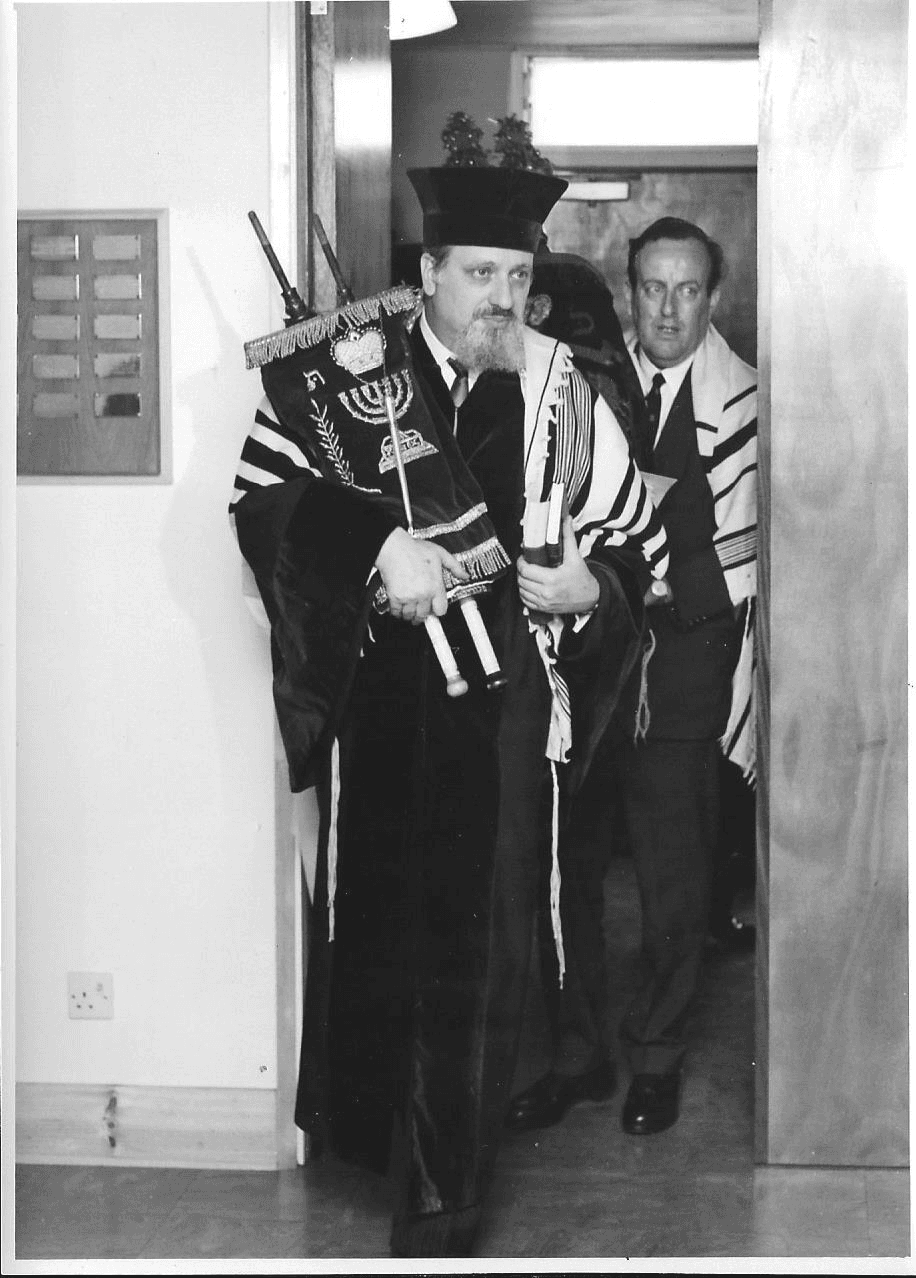
However, despite this and other financial problems the building was completed by September 1968 at a final cost of between £14,000 and £15,000. It was consecrated on 16 October 1969 by the then Chief Rabbi, Dr Immanuel Jacobovitz. (See photo)
The consecration was a memorable occasion; the service being taken by the Chief Rabbi, Rev. Malcolm Weisman and Mr Silman. The Eastern Daily Press reported the event “…an impressive building of which a larger group would be proud.”
It is probably important to mention that the Norwich Hebrew Congregation is an independent congregation, which is not affiliated to the United Synagogue, except in the case of a Synagogue marriage. It maintains an orthodox form of Synagogue service, using the Orthodox siddur, and its male and female congregants sit separately; the ladies at either side of the Synagogue, although in more recent times, families and couples may sit in some designated seating. There is no gallery. The kitchen in the hall is kept kosher. However, over the years, as the members live in diverse parts of Norfolk, very few within easy walking distance of the Synagogue, cars are parked in the area inside the Synagogue grounds, rather than round the corner! We consider ourselves a traditional Jewish congregation.
In 1970, Mr Silman resigned and Harry Levine became our Minister and remained with the community for 11 years. Harry Levine was a teacher who had run a small school in Lowestoft together with his wife Hettie, in the 1940s and they were well known in Norwich and he had previously helped out during High Holyday services.
Harry’s early years as lay-reader/Minister showed his enthusiasm and energy. Apart from his main role on the Bimah on Shabbat, he was a prolific writer, a great people person, a table tennis player and a teacher. With all these skills he brought the Synagogue more into the limelight of the community in general rather than just the restricted small Jewish community. He worked with the students at UEA and encouraged them into the community and Hettie gave regular Friday night suppers to the students. He spoke to many non-Jewish groups about Judaism. This is quite common today, but then it was new. He re-invigorated the Brochure. The brochure which goes back to the late 40s, if not earlier, was produced by Norwich Zionist and Social Society (later known as Norwich Israel and Social Society) and in its early days was mainly a programme of the year’s events; later reproducing articles. It made a lot of money, because it was full of adverts, as many of the members were small shopkeepers or in business. Harry began ‘From the Lay Minister’s Desk’ with lots of local interest, as we do try to do today, but then it was new. He also started a Synagogue table tennis team, and it entered the local table tennis league at Division 9! It didn’t win many matches, but the other teams enjoyed our home made cakes, and hospitality!.
Despite the new shul and the new Minister, the numbers attending services was a constant worry during the 70s. In 1973 a rota of members to attend was suggested and carried out for a while. By 1975 some improvement was seen and it was suggested that maybe women might take a small part – this was firmly vetoed! Kiddush after the services was introduced, but there was a worry that the purchase of the wine was a drain on funds. This was a period when the Cheder was large, 20 children attending in 1976.
During this decade the Presidency of the Synagogue seemed to rotate between Cyril Leveton, Cyril Caplan and Henry Levine and Jack Stern became President in 1978. Victor Bishop was elected Treasurer in 1967 and despite his protestations at various intervals, he did remain Treasurer until 1997!
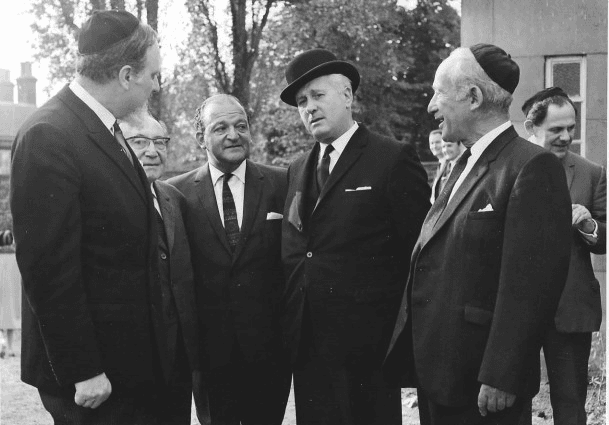
At this period, women had no say in shul affairs, and no vote at the AGM. In 1977 an attempt was made to get them a vote, but at the AGM in 1980, this was rejected. Much later in 1998 wives of members were allowed the same voting rights as their husbands. Nothing moves very fast in Norwich!
Harry Levine retired in 1982, as his health was not good, and he and Hettie moved into a flat in Norwich, and they were made Honorary Life Members. However, over the next few years it proved difficult to find a suitable lay-reader to replace him. Mr Cecil Jackson, a member of the community, was happy to step in during this period and act as a lay-reader and teacher which he did very well indeed and the community was very grateful. I remember he introduced a number of new tunes to the service which he learned from records! He had to work at it for much longer than anticipated because it was not until April 1987 that Menachem Friedman was appointed our next lay-reader.
Prior to a new Minister being even found, members, Sandra and Alan Java offered to decorate the flat for the new occupants which was a marvellous initiative, and they did receive help from a few other members.
Menachem and Ester Friedman had been living in Israel for some years and had wished to return to England. They came initially for a trial period of a few months and stayed for 7 years. Both were very hospitable and fitted in to Norwich very well. The numbers attending services began to improve: Menachem tried all sorts of methods to encourage attendance and to find members – even going through the phone book and calling up all the Cohens and Levys! He was very enthusiastic although he was not happy with teaching and I took over the teaching of the cheder at this time, having helped intermittently during the time that Hettie Levine took it and also during Cecil Jackson’s lay-readership.
In 1985 the first Synagogue newsletter appeared, close to its current form, although produced on typewriter and Gestetner duplicator, and this has been fairly continuous since then.
Hettie Levine continued to organise Communal Seders for some time after Harry retired, numbers attending often between 40 and 60.
In the 1980s mention must be made of the emergence of a new Cultural Society, JACS, organised by member, Sheila Lancer. This society invited some excellent speakers to Norwich and enjoyable meetings were held. Sheila also organised some visits to Norwich by other groups around the country who she showed around the City highlighting the areas of Jewish interest. She moved to Manchester in the 90s, and has sadly since passed away.
In February 1990, the community had its biggest single loss when Harry Levine, Cecil Jackson and Cyril Leveton all died over the same weekend. It was a tragic loss, as all of them had served the community faithfully over many years and the members were in a state of shock.
In June 1993 Menachem retired from the post of lay-reader to return to London with many regrets from members, because he had been a popular lay-reader.
This time, we were not without a Minister for too long as later in 1993, Mark Daniels, who, at the age of 27, was the youngest lay-reader Norwich had ever had, was appointed. His parents had been members for a while when Mark was younger.
Mark brought some fresh ideas and new life into the community, and certainly encouraged more families to become interested. He ran Hebrew classes and organised lectures, ran a Medieval Jewish Philosophy group, started a Judaism Session for the teenagers and introduced a Shevuot Tikkun Le’Eyl (an ‘all night study’ session). In October 1994 the 25th anniversary of the consecration of the Synagogue was celebrated by a special service addressed by Rev. Malcolm Weisman, who had been involved in the Synagogue in his capacity as Minister for Small Communities, certainly since the consecration and before. A big dinner dance with many past members present was also held.
In 1995 Norwich hosted one of Malcolm’s “East Quests” for communities in East Anglia which proved that we had the capacity for large numbers.
The Jewish Ladies Society, who have not featured much so far in this article, but who have been the mainstay for providing Kiddush and catering for many events over the years, celebrated their 100th anniversary in 1996. They celebrated with a magnificent tea party and a ‘This is your Life’ of the Society. The oldest of our members at that time, Florence Burke, aged 98, spoke of the early days of the Society. It was known in 1896 as the Norwich Jewish Ladies Ark Decorating Society!
In early January 1997, a very interesting event was held in Norwich Cathedral when we were represented by our President, Jack Stern. It was the dedication of a newly refurbished Chapel of the Holy Innocents. Part of the service was dedicated to saying ‘sorry’ to the Jews for the 1144 Blood Libel (mentioned earlier). This was a significant point in inter-faith relations.
1997 also saw a first for Norwich, when Ethel Imber-Lithman was elected the first woman President of the Synagogue. She held the post for three years with great credit, and she was not the last woman to hold that office, more followed.
At the end of August 1997, Mark Daniels left Norwich to return to London. He went on to take semichah and become a Rabbi. The Rev. Steven Burns joined us in December 1997. Unfortunately his tenure was quite short and he left the community in June 1998.
The next two years saw a number of different Ministers helping out and taking services, and a few prospective permanent ones who visited, but in 2000 we welcomed Alex Bennett, to be our permanent lay-reader together with his wife, Sandy. Alex had been lay-reader in Colchester for many years but having retired from business he wished to come and live in North Norfolk. He was involved with the students at UEA as Chaplain and was Chairman of the CCJ (Council of Christians and Jews) several times and regularly took part in the Holocaust Memorial Service in St Peter Mancroft. He retired in 2013 after 13 years in post and was an excellent Minister. He and Sandy were made Honorary Members and now live in Gressenhall, near Dereham.
In 2007, the community welcomed the Board of Deputies to Norwich for their annual provincial meeting, for the whole weekend. We also hosted their meeting in 1993, but only for one Sunday. In 2007 we managed to feed about 60 guests and entertain them over the whole weekend, which was initially quite a headache, but was very successful and quite a feather in our cap! We even put on a performance of three of the short stories written by Sholem Aleichem, with thanks to Sandy Bennett’s adaptations, and Barry and I gave them a walking tour of Jewish Norwich.
Following Alex’s retirement in 2013 we were lucky enough to find his successor in Daniel Rosenthal, our next lay-Reader, who had been a Chazan with a good voice, so our services became very musical. Daniel is our present Minister on updating this article in 2020. In early 2020 he was offered a part-time job as Chaplain at three Norfolk prisons which fitted in well with his post at the Synagogue. Previously our member, Paul Stein, held this post, but through ill health, had to relinquish his job which he had enjoyed doing for many years, he died in February 2020.
In about 2015 it was decided that our communal hall’s toilets and entrance hall and kitchen needed refurbishment, which began a big project, which eventually covered the above items but also included quite a lot more work, including re-wiring the Synagogue, which hadn’t been foreseen, although of course it was 50 years old. Nick Simons, our Treasurer, and Marian Prinsley, then the President of the Synagogue, began the project and managed to attract funds from a number of local Charitable Funders which enabled us to proceed. The project attracted funds partly because it was decided to call it the Norwich Synagogue and Heritage Centre, where we would be open to more dissemination of our history and Heritage to others. However, tragically, Nick Simons died very suddenly in 2018, which shocked and saddened everyone. The project naturally came to a halt for quite a while. However, thanks to the very hard work of Marian, who took on Nick’s mantle, it is now on track and work began in November 2020, with hopefully a completion date of April/May 2021. This coincided with the Covid-19 pandemic which struck the world in early 2020, which made everything much more difficult. However we live in hope.
There are many, many events and people that have not been documented here, but I hope that it has given readers a flavour of the life of a small community. It isn’t easy being small and it really needs every member to contribute in their own way if we are to continue far into the 21st century. There will, I am sure, be many more changes in the future. We have a lease on the site in Earlham Road for 900 years (thanks to the foresight of our late President, Victor Bishop), so we have a great commitment to keep our community viable and an important centre for the Jewish faith in Norwich.
books
Books about the Norwich Hebrew Congregation

Norwich Hebrew Congregation - The Story Of A Community - Fifty Years Plus - 1960-2019 by Maureen Leveton
Published in September 2019 to celebrate the 50th anniversary of the consecration of the Synagogue.
This book illustrates the last sixty years of the community and the people who have been involved over those years.
Cost £12 plus postage

Norwich Hebrew Congregation 1840 - 1960 - A Short History - by Henry Levine
This history of the community was written In 1960 by Henry Levine and together with the more recent history cover a 180 years in the life of the Norwich community.
Cost £12 plus postage
Books are £12 + postage each, or purchase both books together for just £23 and free postage.
To order books contact [email protected]
Norwich Synagogue
Norwich Synagogue is a place of worship, community and friendship. We strive to make our synagogue a welcoming place and open our arms to anyone who wishes to join us. We are proud of our history and look forward to making new memories in the future. If you have any questions or would like more information, please don’t hesitate to get in touch. We look forward to hearing from you soon!